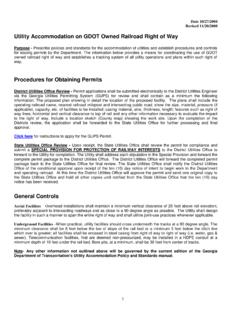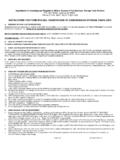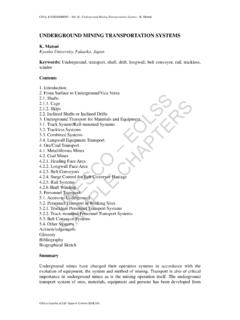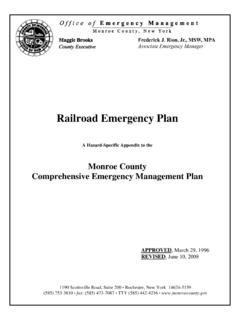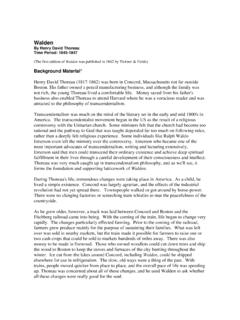Transcription of Frequently Asked Questions Concerning Pipeline Easements
1 Frequently Asked Questions Concerning Pipeline Easements Pipelines perform a strategic role in helping to meet our country s need for fuel and other petroleum products. It is the safest mode of transportation for petroleum products according to the Department of Transportation. Utilization of Pipeline transportation reduces the quantity of refined petroleum products being transported by highway and railway, increasing the safety of those transportation routes. What is an easement? As easement is a legal right to use property owned by another party for a special purpose. An easement does not give its holder a right of possession of the property, but allows the easement holder access to all or a portion of it for a specific purpose. The easement holder typically has the right to access and inspect the property contained within the easement and to place certain restrictions on how the property can be changed, maintained or used.
2 An easement is generally created through a legal agreement with a property owner. This agreement is recorded and effectively becomes attached to the deed for the property. The easement goes with the property, meaning that when the property is sold, conveyed or subdivided, the new owners of the property continue to be bound by the easement agreement. Pipeline companies hold an easement on properties along the path of the Pipeline , intended to ensure the safety of the Pipeline and guarantee access to it for operation, repairs, maintenance, inspection, or in the event of an emergency. The Pipeline itself is generally located approximately in the middle of the easement and typically buried three feet underground. However, a Pipeline may be located anywhere within the easement and its location within the easement may vary within a given property.
3 What is a right of way? The term right of way is often used interchangeably with easement. More specifically, it refers to a right granted as a result of an easement agreement allowing, in this case, a Pipeline company to enter or cross another s property to install, inspect, operate and maintain equipment located on or that crosses through the property. A Pipeline company s right of way is considered to extend along, across, below and above its Pipeline easement. 2 Why is right-of-way clearing necessary? Right-of-way clearing is done for one reason and one reason only SAFETY. To ensure the safety of Pipeline neighbors and the Pipeline itself, Marathon Pipe Line LLC (MPL) flies weekly aerial surveillance of its Pipeline routes and must be able to look down and inspect the route of the Pipeline without interference from trees, vegetation, structures or overhanging branches.
4 It must have immediate access to the Pipeline in the event of an emergency, without delays that the removal of trees or other structures on the right of way could inhibit. There must also be access for routine maintenance and repair to the Pipeline . Can my trees really cause a problem? Yes. Tree canopies prevent aerial inspection of the Pipeline for safety purposes. Tree roots can wrap around pipelines damaging the coating on the Pipeline , which can result in corrosion that can weaken and damage the Pipeline . Trees in the right of way can also block access to the site of an emergency on the Pipeline , creating safety issues for the property owners and the emergency responders. Does an easement agreement mean a Pipeline company owns part of my property? No. If the Pipeline easement traverses your property, it grants a Pipeline company certain rights to use the property in the easement to install, inspect, operate and maintain the Pipeline , but not to possess, buy or sell your property or determine your ability to do so.
5 A Pipeline company with an easement agreement does have the right to transfer or convey those rights granted by the easement to other parties in the future without notice to or agreement by property owners. Do I own part of the Pipeline ? No. The Pipeline company owns the Pipeline and equipment that support, controls and protects it, including portions of it that may traverse your property. While you may own real estate surrounding the Pipeline , you neither own nor are responsible for any portion of the Pipeline itself. In fact, property owners are legally prohibited from activities that could interfere with the safe operation of the Pipeline . How wide is the easement on my property? Pipeline Easements vary from property to property, but many are 50 feet wide, being 25 feet on either side of the Pipeline .
6 The width of the easement was determined when the easement was purchased from the original property owner prior to construction of the Pipeline , though it may have been modified by subsequent agreements. A Pipeline company or its contractors can advise you of the exact location and the width of the easement on your property. 3 How is the route of an underground Pipeline marked? The Department of Transportation requires the use of signs to indicate the location of underground pipelines. Markers like these are located at road, railroad, and navigable waterway crossings. Markers are also posted along the Pipeline right-of-way. The markers display: the name of the Pipeline operator a telephone number where the operator can be reached in the event of an emergency the material transported in the line Markers only indicate the approximate location of the underground Pipeline .
7 They are normally not placed directly on top of the Pipeline . Types of petroleum Pipeline markers are shown below. Painted metal or plastic posts Signs located near roads, railroads, waterways & along Pipeline rights of way Pipeline casing vent Marker for aerial patrol Can I dig near the Pipeline ? Public utilities have established a nationwide network of clearing houses with offices in each state, known as the One-Call System. This is a free public service. To report planned digging, call the One-Call System number in your area. The One-Call Center will notify the appropriate utility to mark the locations of underground lines, pipes and other facilities. Arkansas 1-800-482-8998 Illinois 1-800-892-0123 Indiana 1-800-382-5544 Kentucky 1-800-752-6007 Louisiana 1-800-272-3020 4 Michigan 1-888-482-7171 Minnesota 1-800-252-1166 1-651-454-0002 Mississippi 1-800-227-6477 Montana 1-800-424-5555 Ohio 1-800-362-2764 Pennsylvania 1-800-242-1776 Tennessee 1-800-351-1111 Texas 1-800-344-8377 West Virginia 1-800-245-4848 Wyoming 1-800-849-2476 Do I need to give a Pipeline company with an easement on my property access to my property?
8 Yes. Under the easement agreement, a Pipeline company and its contractors have the legal right to access and inspect the easement, and to cross other areas of your property where necessary to gain access to it. The agreement may provide, and it is MPL s policy, that this access will occur at reasonable hours and with reasonable notice to the property owner, except in an emergency situation. Can a Pipeline company really specify where I can or can t have trees on my property? Yes. Under the easement agreement, the Pipeline company and its contractors have the legal right to prevent encroachment on (interference with) the right of way, and to remove or modify trees and/or other structures that encroach on or block access to it. This may include trees that are rooted outside of the right-of-way (even on adjacent properties), but which overhang the right of way such that they prevent aerial inspection, or which could otherwise interfere with the Pipeline or access to it.
9 What about the fences, sidewalks, driveways or other surface structures on my property? These structures may not pose a problem, as long as they can be easily removed or dismantled for emergency access and do not block routine inspection of the Pipeline and the easement. In most cases, these structures would be repaired or replaced if they were damaged during routine or emergency operations. Keep in mind, however, that if these structures are located within or across the easement, they are encroachments, and they could be removed without compensation or replacement. What does clearing mean? Right-of-way clearing is the removal of trees, vegetation over three feet high, or other encroachments within the right of way. It includes the trimming of branches that 5 overhang the right of way and prevent aerial surveillance of the Pipeline .
10 A Pipeline company representative will attempt to discuss property-specific issues with the property owner prior to the start of all clearing activities on the property during a pre-clearing inspection. What will happen on my property during the clearing operation? A representative of the Pipeline company will contact property owners in advance of clearing operations to discuss what will occur at the time of clearing. Typically, MPL will attempt to contact property owners in person one week before the planned clearing. If they are not successful in having a face-to-face discussion, material about the clearing operation is left at the property owner s home along with information on contacting a Pipeline company representative. Follow-up phone calls are made to the property owner to discuss clearing plans.
